Perennial cathedral ceiling ice dam issue meets hot roof twist
Martin Holladay, I can imagine you grinding your teeth at yet another tongue and groove cathedral ceiling issue! I thought I could be smarter than the problem. #fail
Background: of our design https://www.greenbuildingadvisor.com/blogs/dept/qa-spotlight/designing-hvac-system-cold-climate
Problem: double-walled stovepipe penetrating cathedral ceiling / hot roof appears to be source of heat leak, spurring ice dam and interior condensation on cathedral room walls. (see photos)
Setting: 1,100 sq foot construction. About 28,000 btu heat load. We close off unused bedroom and mudroom. Cathedral roof (4/12 pitch) is insulated with closed cell foam ~R56). Raised heel trusses. Bedrooms either side of great room are cold roofs with spray foam on sheetrock lids, then blown-in cellulose. Meticulous building envelope with .8 blower door test. Inside humidity throughout the winter has been low 20s. High teens when I fire up the wood burning stove.
Recessed lights. Ah, yes, the ol’ pot lights problem. However, the lights with LED 200W equivalent bulbs are located in conditioned space with at least 16″ clearance between pan and hot roof insulation. Given these conditions,I can’t see hot the pot lights can be contributing to the ice dam problem.
HRV air exchanger. Fujitsu mini splits. Jotul stove is about 23,000 max btu. We used stove maybe a dozen or so times, primarily when night temps were below -15 degrees. Passive solar heat is primary daytime heat source, when there is sun (scarce this winter).
Builder’s Proposed Solution Remove inside stovepipe collar where it penetrates cathedral ceiling. Insulate stovepipe with rockwool in space between ceiling and roof deck. Cut interior vents at low end and high end of t&g ceiling. Thinking is that the vents could create a convection loop to vent moist air.
Warm air rising in the winter to the peak of the cathedral would seem to be a hindrance to the convection loop idea. Perhaps our ceiling fan could help ventilate the space if we did go with vents. However, my wife and I are not keen on the cathedral ceiling venting idea. We live in the country alongside a lake with periodic hatches of flying bugs. We don’t want to create a space for bugs, spiders, etc.
Question 1 Comments on likelihood of success with proposed solution? Any variations?
Question 2 Assuming rockwool approach, is there any need to hold the rockwool back from stovepipe given its fire resistance? Would building a chase to contain the rockwool and provide opportunities for caulking add value to containing the stovepipe heat?
Question 3Assuming that the builder has correctly diagnosed the problem, do folks have any other proposed fixes to the condensation on the walls, heat loss through roof, and subsequent ice dam?
Final comment: we are delighted with how well our triple pane, high solar heat gain Alpen windows helped heat our home during the winter. Typically, we reached 79 to 81 degrees in our great room, no matter how cold outside. Concrete floors reached similar temps later in the day. I wish though that we had put more exterior insulation on the slab on grade perimeter (currently have 2 inches). Floor perimeter is significantly cooler. Love our clerestory windows and look forward to using them to “night flush” heat out of the house in the summer. Unexpected bonus of clerestory windows is being able to see the moon and stars at night.
GBA Detail Library
A collection of one thousand construction details organized by climate and house part



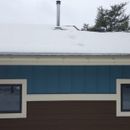
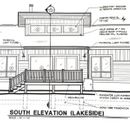
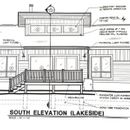
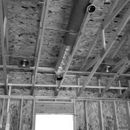
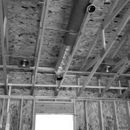







Replies
Clarification question: Is the spray foam sprayed against the bottom of the roof, on the top of the tongue and groove? I'm guessing the foam is against the bottom of the roof deck.
In the picture of the ice dam, it looks like thicker ice on the left, rather than below the chimney. I'm not sure why that would be the case, but it doesn't seem to implicate the chimney as the source of the problem. What's your confidence that the spray foam is truly R-56, rather than R-56 based on some bogus equivalence that seeks to claim Rs of spray for are better than Rs of regular insulation? Do you know the actual thickness of spray foam?
Is there any way to get a temperature probe into the space about the tongue-and-groove? That could be interesting data. Not someplace close to the stove pipe, but somewhere on the other side.
Charles, good point about ice dam thicker to the left. At same time, melted snow areas are to the right, albeit not adjacent to stovepipe, are suspicious. The other clue pointing towards the stovepipe is condensation on the interior wall down slope from the stovepipe.
Yes, the spray foam is against the roof deck. Our builder had the insulator place an upside down ruler in the foam so we could see how thick it was -- 10". Consistently 10" throughout? No way to know. There is also spray foam on the side walls of the great room beginning at the top plates and extending to roof deck.
Insulator contractor scanned the interior ceiling and walls with thermal imaging attachment to his phone. He didn't see any unexpected hot / cold spots. We could drill a hole in t&g or pull of the end trim to get a temp probe in the vacant space. Can you tell me more about what you are thinking on the probe?
Thanks for your comments.
Randy I was having a similar issue with our wood stove pipe and I did what your builder is suggesting and added Roxul around the pipe in the attic all the way to the roof. After a half winter of burning the Roxul looks exactly as it did when I installed it and seems to have no issue with the heat from the stove. The hot portion of the roof by the stove outlet is less severe now as well. I will warn you that when our local inspector came out to sign off on another project he didn't like the idea of the Roxul and told me it needed clearance on all sides around the pipe. After discussing the fact that Roxul is fine past 1,000 degrees and if a wood stove pipe got over 1,000 degrees there are more serious issues because the house is on fire he relented and basically said "let's just pretend I didn't see it". Not saying this is or is not the right thing to do just my experience.
On the temperature probe idea, I was thinking that it would be a way to check that that space isn't somehow getting heated to an unreasonably high temperature. But hearing that you verified your spray foam thickness pretty well, I'm less worried about that, although I'm still puzzled by the location of the ice in the photo. It might be that somehow ice under the snow diverted the melt from the chimney to flow over the the left part of the photo, and the chimney is the source of the problem.
Randy,
Here are my questions:
1. You call this an ice dam? I don't see much ice thickness; I see zero icicles; and I didn't hear you mention any roof leaks. Are you sure that you have an ice damming problem? Below is a cropped version of your photo -- I wouldn't necessarily call this a problem.
2. No one has yet focused on the most curious statement in your post: namely, that you have "interior condensation on cathedral room walls." Say what? It sounds like your walls are cold or your indoor relative humidity is high, or both. This sounds like a totally different problem from ice damming.
.
Yup, Martin. Damn small ice dam -- this year.
Good point about the cold wall causing condensation. We have had very low interior humidity all winter. The location of the condensation streaks on our wall appear associated with the stovepipe. So, if we can insulate the stove pipe in the space between the t&g and roof, it seems to follow that we could potentially solve the condensation and gigantic ice dam. :-) Close-up pic attached
Randy,
I'm more confused than ever. You wrote, "The location of the condensation streaks on our wall appear associated with the stovepipe." But in your photo (below) I don't see any signs of wall stains near your metal chimney. (When you wrote "stovepipe," you meant "metal chimney" -- right?)
Are you implying that the mechanism is the following?
1. The house is under negative pressure (perhaps due to the operation of exhaust fans).
2. The wood stove is usually idle (without a fire in the firebox).
3. Negative pressure is pulling cold outdoor air down the chimney.
4. The chimney is cold enough to lower the temperature of nearby drywall?
If that's what you are theorizing, I don't buy it. It's highly unlikely.
.
The pic in comment 6 appears to be a valley. Valleys are always far more prone to ice dams than other roof areas. They collect water from a large area. They are slightly warmer by virtue of their geometry, just like the outside of an outside corner is colder.
Martin, I am following your clue about a cold wall. There are cold roof attics adjoining either side of the room with wood burning stove. Thus, a portion of the walls above the cathedral ceiling, beginning at the top plates adjoin the cold attic.
Subsequently, if heat from stovepipe in the between t&g cathedral ceiling and roof deck is hitting a cold wall, then potential for condensation. However, the space above the t&g is is inside the building envelope and technically conditioned space. So, maybe I have gone done a rabbit hole to no where.
Could the steam from our dinky teapot when the stove is fired be an issue? Most of the time the teapot just wafts steam. Several times with a hot fir it has been continuous steam. Yet we seldom use the wood burning stove.
Martin, the condensation streaks on the wall down slope from stovepipe are so slight that they are virtually invisible to a camera. the cropped photo above was taken during construction before winter.
I forgot to add, we do not have any exhaust fans, given ventless dryer. No stovetop exhaust. We rely upon balanced HRV and its return ducts in bathrooms and kitchen
Randy,
As I said before, the only way you can have condensation on your walls is if (a) your walls are cold, or (b) your indoor RH is elevated, or (c) both a and b.
Could a boiling teakettle on your wood stove be raising your indoor RH? It could certainly be contributing to a problem, I suppose. But you report that "We have had very low interior humidity all winter." Your statement raises the question, "What do you mean by 'very low'? Did you measure it?"
If there is a cold attic on the other side of the wall with condensation, I think that you should investigate whether the wall is adequately insulated. What type of insulation was used? Is the insulation in direct contact with the drywall? Are there good air barriers on both sides of the wall insulation?
Martin, I will have to ask builder about wall detailing between great room walls and cold attics. We have six thermometers stationed around the house, which feature humidity readings. It's so dry, for example high teens today, that we will have need humidifier next year.
I'llace report back how we address issue. Thanks everyone for your input
Randy, sorry to hijack this thread, but can you provide some info on your gutters?
A commercially available product or custom?
Thanks.
Brian, the large half-pipe gutters were formed on site by Advantage Seamless Gutters of Brainerd, MN. Shape and size are supposed to facilitate moving large volumes of water and help reduce the build-up of leaves and debris. We have yet to occupy our new home during the reason season. So, I don't have any performance experience with the gutters
If the walls between the great room and the cold attics are not well insulated, that could explain both the wall condensation and the ice damming, if the location of the most ice damming is consistent with that explanation.
Charlie, we have spray foam on the walls between great room and the two cold attics. I don't yet know the R value applied. Thanks for helping me think thru the issue.
Randy,
Mulling your issues, I realized how easy it is to make assumptions based on how a question is phrased.
You asked us about your ice dam problem, and it took me a bit of thinking until I realized that you may not have an ice dam.
You asked why you have condensation on your wall, and I just realized that you may not have a condensation problem. It's possible that you have a minor roof leak.
I too don't see much evidence of ice damming.
But after looking at your prints and photos, and reading and re-reading everything, my inclination is to wonder about the wall. Perhaps I misunderstand, but you mention the wall is next to a cold roof attic? And the wall abutting these spaces are not only insulated well, but airtight as well? You mention the tight blower door results, which would seem to indicate all is well in that regard. I assume the wall streaks you're referring to are near the stove on the sidewall of the clerestory? And you say the humidity level is very low. You also mention the very infrequent use of the stove and "teapot humidifier".
But I wonder if the streak issue might be a combination of 1. Colder wall adjacent to cold roof attic space, 2. Use of the stove and "teapot humidifier" on a particularly cold, "below -15°" day, and the resulting colder wall than normal, 3. A higher humidity level than normally noted, at that particular location, and 4. The resulting streaks being a one time or infrequent result of a combination of all of the above. Therefore, the streaks being a one time or infrequent time phenomena rather than an ongoing problem.
More than once I've seen streaks on a wall from a one time event become a semi permanent marring of the wall until it was eventually sealed, re-primed, and repainted. Perhaps addition of showers/cooking without a dedicated exhaust adding to the issue on the -15° day?
I live in Maine, and we seldom if ever see much below zero like you might in Minnesota. But I did a total gut and remodel of our ranch, bringing it to an effective wall R value of R35, roof R70, basement R35 down to R20 below ground. In addition, it is VERY tight, so there is virtually no air infiltration, and although I did not do a blower door test, I feel confident in the results. As testimony to this, I built a round house where the HERS rater said it was the tightest house he'd ever tested. It achieved .4 at 50 pascals, which more than meets Passive House standards. Of course, I also use an HRV with exhaust from baths, laundry closet, and kitchen areas, and supply to living and bedroom areas. Our humidity typically runs 40-50%, much higher and I believe healthier than yours, but it's not as cold here. We have zero ice dams, even if, like last winter we had up to 3' of snow accumulated on the roof before I finally shoveled it off midwinter.
I also wonder if air being pulled in from the stove is contributing to the very low humidity in your home. I did a cottage near Cape Cod in Massachusetts where the owners originally wanted a small stove, but I told them that it would not help their energy use, in fact it would add to the energy used, given the "open hole" to the outside. So they decided not to install one. They ended up with an all electric home, with extraordinarily low energy use and comfort. Just a thought regarding your stove. It may not help your situation. I would suggest an electric heat backup if needed.
Finally, as your code enforcement officer noted, I know code does not allow insulation in the space between chimneys and framing, etc., however, I think he reasonably let it go based on the fact that 1. There is likely an already insulated metal chimney in your installation, and 2. As you pointed out, mineral wool insulation is good to 1000°. So you have redundancy with at least 2 stages of protection, and no doubt your code guy realized that, and complied with the intent of the law. It's nice when we have code enforcement officers that not only know the building science behind the codes, but also are therefore more reasonable in their requirements. Kudos to him!
Sorry about the long winded reply. I wish you the best in your trouble shooting efforts.